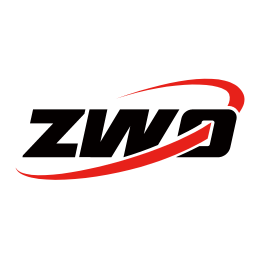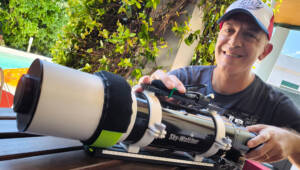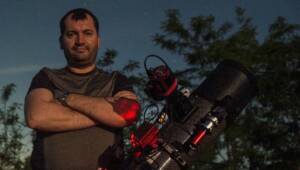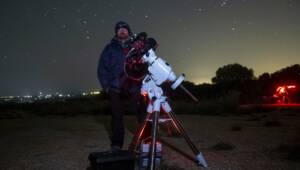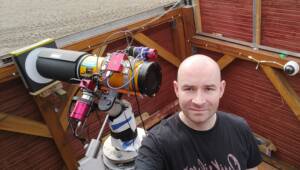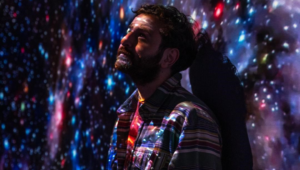Hello Robert, thanks for accepting our interview invitation. Congratulations on winning the ASIWEEK competition in week #44/2023!
Q1: At first, congratulation that your nice image won #ASIWEEK. Can you introduce yourself to us?

Thank you so much for choosing my image, this was a big surprise! My name is Robert Eder, I’m a sound engineer and I have a mastering studio in Vienna, Austria. And of course, I’m a passionate astrophotographer. Unfortunately, as I live in the big city with heavy light pollution I have to travel 1 hour to the next bortle 4 place and 2,5 hours to my new bortle 2 place.
Q2: When did you start astrophotography and how?
I got my first telescope when I was a teenager, a very long time ago. It was a 115mm Newtonian. Back then I photographed the moon and the planets and some of the bright objects like M13, Orion and Andromeda. This was on film! Then I moved to the big city with heavy light pollution and I had no car. So I stopped using it and sold everything. Many years later in 2016, it hit me again and I bought a Sky Watcher 8″ Newtonian, mainly for visual observation. But after a few months I wanted to see more and I started photographing with my DSLR. From there it went the usual way. A laptop, autoguiding, more and longer exposures etc. But till today it’s always a mix of visual observation and imaging. I always have two setups, one for imaging and one to look through the eyepiece and imaging.
Q3: Can you tell us about the winning photo?
I have now access to a very dark bortle 2 place. The Milky Way is so bright, that it’s sometimes difficult to find the constellations. So I thought this is a great place to capture some faint dark nebulae like the Helping Hand in Cassiopeia. I ran it for 3 nights and got 18 hours of integration time. There was almost nothing to see on the single lights, but after the first stack, wow! My goal was to make the nebula really pop out and I’m very happy with the result. For this image I only used one of my twins’ scopes because I still need a second ASI2600. But I haven’t decided yet whether mono or OSC.
Sky Watcher Newton 130PDS
Sky Watcher EQ6-R Pro
ZWO ASI 2600MC Pro
ZWO ASI 120MM Mini (guiding)
Gain: 100, Offset: 50, Temp: -10°C, 247x 180”, 38x 540”

Q4: How do you normally do post-processing? Would you like to share with us your workflow?
My workflow changes a lot when I try new things. I prefer Astro Pixel Processor for stacking and the Ha and OIII extraction. Then I go into PixInsight for Blur- and NoiseXterminator and back to Astro Pixel Processor for background extraction, star color calibration and stretching. I’m not a PixInsight guy, my brain doesn’t work that way. I do the rest in Photoshop, because with the exception of star removal and denoising, almost everything is in realtime. I’m so used to that and I need my layers. But that may change some day, who knows.
Star clusters and galaxies usually form relatively quickly, perhaps 1-2 hours (after stacking).
Nebulae take much longer. Usually I do an RGBHOO mix of broadband and dual band (from my twins setup). This can take between 3 and 4 hours to even a day. I spend a lot of time on color balance. For me, the most important thing is to know what to do to get exactly the result I have in mind. And that only comes with experience and more experience.
It is also important to be patient and let it sit for a day or two. Often I post my images way too early, right after they’re finished and the next day I discover bad things and I have to change them.😄



Q5: What gear do you use? Any pictures of them?
2x Sky-Watcher Explorer 130/650 PDS on a EQ6-R Pro dual rig. With this one I shoot OSC and dual band at the same time, this is very handy in the short summer nights.
Sky-Watcher Explorer 200/1000 for visual, planetary and smaller objects
Sky-Watcher EQ5-N for visual observation (and imaging if there is no wind)
Omegon MiniTrack LX3 for wide fields with a Canon 600Da and different Canon lenses.
ZWO ASI120MC-S, ZWO ASI2600MC-Pro, ZWO ASI533MC-Pro, ZWO ASI120MM-Mini, Optolong dual band filters, 3x Canon 600D modified and cooled.


Q6: What different experiences do planetary and deep sky photography give you? Any tips you can share?
Planetary is all about seeing, focusing, a fast camera and waiting for the right moment. You have to be patient, sometimes the seeing can go from bad to great in a matter of seconds. And of course you need a large aperture and a long focal length, which I don’t have yet. I’m still saving for large Dobson or a C11 Edge HD, I havn’t decided yet.

Deep sky is all about a good mount, good guiding and as much integration time as you can get. Everything takes much longer, the acquisition, the processing and the learning curve. But I love them both and I also do some spectroscopy from time to time. I always try to give my images a cinematic look whenever possible. I spend a lot of time on framing and color balance to add some depth to the image.


Q7: What’s your favorite of the targets you’ve shot?
It’s impossible for me to choose just one, there are too many, but here are a few.




Q8: Is there any memorable story you can share with us from your astrophotography days?
Yes, during the lunar eclipse 2019, there was a meteoroid impact on the moon and I cought it. I sent it to NASA and they wanted the raw files. They took eight pictures of the impact from differnt parts of the world to calculate the impact. It was a student project and part of a later APOD. That was very exciting.

Q9: How do you balance your time between hobby, work and family?
Unfortunately, since I live in Austria, the weather is cloudy and windy most of the time. I usually only have one clear, moonless night per month, so balance isn’t an issue. That’s why I have three rigs to get the most out of this one night.

Q10: What do you consider to be your highlight moment in astrophotography?
That’s a tough one to answer. Maybe my second APOD. The first was for processing a Hubble image, but the second one was with my own, which of course counts much more.
The first cover of a magazine was also very cool, it’s hard to say.

Q11: Do you have any advice for newcomers to astrophotography?
The most important gear is the mount. Start simple, maybe with a DSLR if you already have one. Join a local astronomy club. Work on your skills first, especially the processing, then upgrade your gear. I always try to get the best out of the equipment I have, that’s where you learn the most. Just constantly buying the latest gear won’t make you a better photographer. I made an APOD with just a 200€ Newtonian and an old Canon 600D. Prepare well for your sessions. I always check the framing in Stellarium at home and put the coordinates into the acquisition software. If you have to travel like me, once again make sure you don’t forget anything and check that everything is working.
Don’t give up too early, be patient, it takes time, – many years.

Q12: When did you start using ZWO’s products and do you have any suggestions for us?
My first one was the ASI120MC-S in 2020 for planetary Imaging and guiding. Now I also have an ASI2600MC-Pro for deep sky, an ASI120MM-Mini for guiding and an ASI533MC-Pro which I like very much because it’ so versatile. I use it for spectroscopy (because it doesn’t have a built in UV/IR-cut filter), for the moon and sometimes even planets, and for smaller depp sky objects like galaxies. I’m very happy with the ZWO products, I never had any issues so far, they just work.
Suggestions, hmm, I don’t need 100MP, but a new sensor with higher sensitivity, wider dynamic range and less noise is always welcome.
Q13: Would you mind sharing with us your upcoming shooting plans?
I have a long list, the next ones are, NGC 1333, Seehorse Nebula Barnard 150, Fireworks Galaxy NGC 6946, Cat’s Eye Nebula NGC 6543 (a challange), some spectroscopy and the moon and planets whenever the seeing is good.
You can view my images here: https://www.astrobin.com/users/Robsi/
